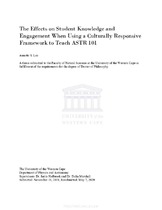| dc.contributor.advisor | Holbrook, Jarita | |
| dc.contributor.author | Lee, Annette | |
| dc.date.accessioned | 2020-07-03T15:58:43Z | |
| dc.date.available | 2020-07-03T15:58:43Z | |
| dc.date.issued | 2020 | |
| dc.identifier.uri | http://hdl.handle.net/11394/7274 | |
| dc.description | Philosophiae Doctor - PhD | en_US |
| dc.description.abstract | The U.S. has a problem: it is not effectively utilizing all the bright young minds available to its science & engineering workforce. In 2012 the President’s Council of Advisors on Science and Technology (PCAST) reported that a million more STEM professionals in the U.S. workforce were needed over the next decade. PCAST reported that the situation is far worse for underrepresented students, who make up 70% of undergraduate students but only 45% of the STEM degrees. Recent reports suggest women in science and engineering have made small gains, while historically underrepresented ethnic groups (Blacks, Hispanics, American Indians) continue to be significantly underrepresented. The lack of diversity in the U.S. workforce is not reflected in the USA population nor is it reflected in the undergraduate student population. As the U.S. aspires to retain a leadership role in research and development in an increasingly diverse and globally interconnected society, this disparity is unsustainable. What if having more culturally interesting, more culturally responsive STEM classes is a way of increasing the diversity of the science and engineering workforce in the U.S.? This study focuses on a topic that has been generally overlooked by the STEM educational community, but one that is directly relevant to student engagement and learning outcomes: the role of culture as a variable in student learning. This study examines how different pedagogical approaches shape student outcomes in Astronomy 101 courses. In a comparative study two different pedagogical approaches were analyzed using both quantitative and qualitative methods in a semiexperimental nonequivalent group research design. The theories of culturally responsive pedagogy (CRP), active learning theory in STEM, and Indigenous knowledge systems (IKS) ground this approach. The findings of this study show important gains for all students. Underrepresented minority students (URM) in the course with increased culturally responsive pedagogy were exceptionally engaged and learning gains soared. By measure of the concept inventory, the URM students in the course with increased culturally responsive pedagogy outperformed all other students in the study. As the U.S. will have a non-white majority by the year 2045 and diversity in STEM faculty lags there is a need for tangible, evidence-based, culture-based curriculum and pedagogy. There is a problem and based on the evidence found in this study, there is a way to fix it. | en |
| dc.description.sponsorship | The U.S. has a problem: it is not effectively utilizing all the bright young minds available to its
science & engineering workforce. In 2012 the President’s Council of Advisors on Science and
Technology (PCAST) reported that a million more STEM professionals in the U.S. workforce
were needed over the next decade. PCAST reported that the situation is far worse for
underrepresented students, who make up 70% of undergraduate students but only 45% of the
STEM degrees. Recent reports suggest women in science and engineering have made small gains,
while historically underrepresented ethnic groups (Blacks, Hispanics, American Indians)
continue to be significantly underrepresented. The lack of diversity in the U.S. workforce is not
reflected in the USA population nor is it reflected in the undergraduate student population. As
the U.S. aspires to retain a leadership role in research and development in an increasingly diverse
and globally interconnected society, this disparity is unsustainable.
What if having more culturally interesting, more culturally responsive STEM classes is a way of
increasing the diversity of the science and engineering workforce in the U.S.? This study focuses on
a topic that has been generally overlooked by the STEM educational community, but one that is
directly relevant to student engagement and learning outcomes: the role of culture as a variable in
student learning. This study examines how different pedagogical approaches shape student
outcomes in Astronomy 101 courses. In a comparative study two different pedagogical
approaches were analyzed using both quantitative and qualitative methods in a semiexperimental
nonequivalent group research design. The theories of culturally responsive
pedagogy (CRP), active learning theory in STEM, and Indigenous knowledge systems (IKS)
ground this approach.
The findings of this study show important gains for all students. Underrepresented minority
students (URM) in the course with increased culturally responsive pedagogy were exceptionally
engaged and learning gains soared. By measure of the concept inventory, the URM students in the
course with increased culturally responsive pedagogy outperformed all other students in the study.
As the U.S. will have a non-white majority by the year 2045 and diversity in STEM faculty lags
there is a need for tangible, evidence-based, culture-based curriculum and pedagogy. There is a
problem and based on the evidence found in this study, there is a way to fix it. | en_US |
| dc.language.iso | en | en_US |
| dc.publisher | University of the Western Cape | en_US |
| dc.subject | Higher education | en_US |
| dc.subject | United States | en_US |
| dc.subject | Culturally responsive pedagogy (CRP) | en_US |
| dc.subject | Culturally relevant pedagogy | en_US |
| dc.subject | Pedagogics | en_US |
| dc.subject | Cultural astronomy | en_US |
| dc.subject | Indigenous Knowledge Systems (IKS) | en_US |
| dc.subject | Indigenous Scientific Knowledge Systems | en_US |
| dc.subject | Discipline-Based Educational Research (DBER) | en_US |
| dc.title | The effects on student knowledge and engagement when using a culturally responsive framework to teach ASTR 101 | en_US |
| dc.rights.holder | University of the Western Cape | en_US |

